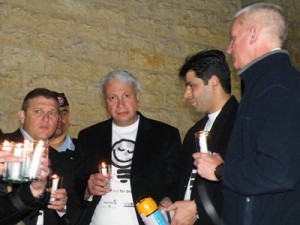Identifying opportunities for contributing to climate change policy and institutional innovations were a key priority at the Global Development Network’s 10th Annual Conference in Kuwait, which Green Prophet had posted on earlier.
The rest of this report, was penned by conference organizers at the GDN Network: This 10th annual conference on ‘Natural Resources and Development’ ended on February 5 in Kuwait with about 450 researchers and policy-makers agreeing that policy steps can be taken to turn resources into a blessing.
Two workshop sessions sought to take the stock of current research and analytical effort on climate change; identify thematic priorities, data constraints and methodological issues.
There were four presentations on the stocktaking exercise. The first by K.S. Kavikumar, Madras School of Economics, India, discussed issues related to climate change from a developing country perspective.
The second by Stephen Howes, Professorial Fellow, Crawford School of Economics and Government, Australia, presented an example of a climate change review from a developed country perspective, in this case, Australia.
The third by Ram Gopal Agarwala, Senior Adviser, Research and Information System for Developing Countries (RIS), India, presented new ideas for an institutional approach to climate change. This was followed by a presentation by Sergio Margulis Lead Environmental Economist, World Bank, on a climate change review exercise from a developing country perspective – Brazil.
According to K.S. Kavikumar, “we need to know what the impacts are. But we need to refine our conceptualization of the impacts. A key constraint is lack of data. We also need to account for spatial effects.”
He also emphasized the fact that vulnerability is important because it helps us to understand adaptation. However, there is a need to clearly define it. He also raises the issue of methodology. Index-based are currently in use. But we need to develop aggregation methodologies that are more broad-based, e.g., taking into account development and disaster management.
According to him, we need also to consider whether we are adapting to climate change or to climate variability. Other key issues are the timing, the method, the costs and the scope for insurance. Regarding mitigation, the scope for market-based instruments is limited for developing countries.
There is a need to consider well designed alternatives. There were a number of comments after his presentation related to costs of adaptation. The estimates of costs are very important as there is very little substance to the aggregate costs used in the global reviews (e.g. Stern, IPCC). The use to which these estimates are put is also very important.
The Garnaut Review
After that, Stephen Howes made a presentation on the Garnaut Review. Garnaut Review is an independent national review with a focus on mitigation policies and cost benefit analysis. The review modelled climate change impacts under three global emissions scenarios, taking into account impacts on agriculture, industry and health.
According to Howes, the key lessons we can learn from the Review are that “because of financial constraints, we must be selective. Also, policy makers respond to arguments that are put in national interest or national review lens. Lastly, Cost Benefit Analysis of climate change action is a useful approach but we need to do that in vigorous way.”
Comments related early warning systems, mitigation, institutional learning and climate modeling.
Climate Change Negotiations Needs Consensus
The third presentation was made by Ramgopal Agarwala on climate change negotiations. According to him “strenuous efforts have been made in the past two years and yet very little progress has been made towards a consensus. Currently, the developed and developing countries are not on the same page.
“So we need to think outside of the box. We need to have bold alternatives to the current Bretton Woods institutions.”
He then proposed a new approach: “there is a need for global government to manage global climate change because it is a global public good. We need global governance with powers of taxation and accrual of climate change seignorage. The international component of carbon taxes should accrue to global financial institutions for supporting time-bound action programs for reducing carbon intensity for development. Seignorage generated by global liquidity needs to be used, at least in part, for provision of global public goods.”
Opens lots of questions
A number of questions and comments followed his presentation. How can development concerns be accommodated in this framework? What will be the carbon content of the atmosphere by 2050? There is an adaptation dimension which does not fit into this global public goods framework. Can lifestyles be changed by politicians? What about practices at the community level? The latter, it was felt, was an important aspect of climate change research.
World Bank Economics
Finally, Sergio Margulis made a presentation on World Bank Economics of Adaptation to Climate Change and Brazil Economics of Climate Change. The presentation pointed out the need of criteria for adaptation, the necessity of capacity building, the prioritization of research gaps and the need to associate the private sector in the climate change agenda.
It raised also many questions related to the cost of adaptation, social and distributive impacts, alternative actions and eventual trade-offs.
Comments were mainly on the necessity to consider different categories of developing countries and to look at adaptative capacities.
Sergio Margulis continued on the second day from where he left off, with a presentation on “Economics of adaptation including methodological issues.”
Margulis presented the methodology behind the study on the economics of adaptation and climate change being conducted by the World Bank and financed by the governments of the UK, the Netherlands, and Switzerland.
The focus of the study, he said, is on how to cost climate change impacts and how to incorporate adaptation into development plans. The objective of the study is to come up with a global cost for adaptation.
The study is not just an academic study as there is a need for UNFCCC negotiators to have some numbers. Margulis stressed the complexity of developing a cost methodology that needs to take into account issues such as the definition of costs (baseline, additionality to development, sensitivity analysis for different definitions); the relationship between adaptation and mitigation; the types of adaptation; uncertainty; and different time frames.
He then presented the adopted methodology which includes two tracks: an aggregate track and case study track (6 countries in depth case studies). He also presented the methodology behind the case studies (covering costs of impacts and adaptation measures).
During the discussion, some participants questioned the pertinence of coming up with a number. Margulis said that this was a political request but that the value added was probably more on the process and the partnerships being built through this exercise.
Answering a question about the role of ecosystems, Sergio highlighted the difficulty of estimating ecosystems services where technical information was weak. He also mentioned that ecosystems services were nevertheless integrated to more robust estimates (e.g., agricultural productivity).
Answering to a question about using what has already been done by developing countries, Margulis said that the case studies were taking into account NAPAs and such but that the costing methodologies behind them was sometimes not reliable.
Answering a question about health and the data gaps existing in this sector, Margulis concurred. Answering to another question, he clarified that the study was not a global model but rather an aggregate of sectoral models.
After Sergio Margulis, Youba Sokona, Executive Secretary, Sahara and Sahel Observatory (OSS), gave a presentation on the Challenge of Adaptation in Low Income Areas. Sokona identified several potential research areas that GDN could consider.
According to him one important element of research for any developing countries is to find the grey area between adaptation and development – what is the nexus? What are the differences between climate adaptation and development taking into account the different climate scenarios (implications of being under or above 2 degree Celsius are very different)?
Sokona mentioned that there were different types of adaptation. There is spontaneous adaptation and there is reactive adaptation.
He stressed that negotiations were focusing on the latter. Sokona also said that there were currently three different types of adaptation research priorities:
(i) observational systems (with weather and socio-economic indicators)
(ii) infrastructure
(iii) Institutions (do we have the right institutions to cope with adaptation at the national level?)
He said that the latter could be one interesting research area for GDN – the poorer the country, the weaker the link between science and decision-making. His view was that GDN should focus on action related research to inform the negotiations and to facilitate action nationally.
Other areas for research that Sokona identified were:
• Metrics for adaptation. To define adaptation we need to go beyond countries and sectors and rather focus on agro-ecosystems.
• Relevance of sectoral approach to study adaptation. The sectoral approach is relevant for mitigation but maybe not for adaptation.
• Focus on the most vulnerable areas: Should we define a baseline for the soft part of adaptation (proactive action) to complement the hard part (infrastructure – reactive action)?
• Monitoring and evaluation of actions implemented for adaptation.
During the discussion, the debate focused on quantitative type of studies versus historical experience based type of studies. One research methodology could be to base the study on well documented areas and look at the costs identified in these areas as well as their associated policies. Participants also discussed the pertinence of the country level study versus agro-ecosystem or river basin studies.
(This report was provided by the GDN Network following a Green Prophet story on the conference in Kuwait. It’s a bit long, we agree, but I thought to post it in its entirety for climate change specialists to review.)
More green events:
Abu Dhabi Sets Renewable Energy Goals at World Future Energy Summit (Jan, 2009)
Eilat Renewable Energy Conference in Israel Full Steam Ahead (scheduled for Feb.)
Sustainable Architecture Conference in Libya (Jan, 2009)
Designing from Nature at Jerusalem’s Green Design Conference (Jan, 2009)
Image credit: architopher





One thought on “Kuwait Perspective of How To Take Stock of Climate Change”
Comments are closed.